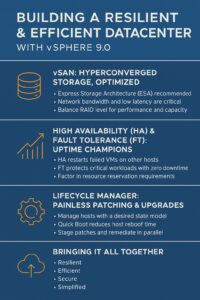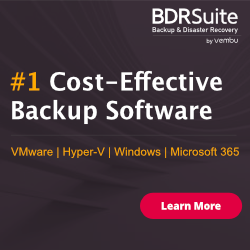
We’ve reached the final post in our vSphere 9.0 Performance Series!
So far, we’ve optimized:
-
Hardware and hypervisor settings
-
Guest OS configurations
-
Cluster management with DRS and vMotion
Now, it’s time to bring everything together to build a datacenter that is:
-
High-performing
-
Resilient
-
Secure
-
Easy to manage
In this post, we’ll focus on three essential technologies:
-
vSAN – Hyperconverged storage for speed and scalability
-
High Availability (HA) & Fault Tolerance (FT) – Keeping workloads online
-
Lifecycle Manager (vLCM) – Simplifying updates and patching

1. vSAN: Hyperconverged Storage, Optimized
vSAN pools local disks from ESXi hosts into a single, distributed datastore, delivering powerful and flexible storage.
vSAN Architecture Options
Original Storage Architecture (OSA)
-
Uses disk groups:
-
1 cache disk (SSD) for performance
-
1+ capacity disks (SSD/HDD) for storage
-
-
Works well, especially with all-flash configurations.
Express Storage Architecture (ESA) (Introduced in vSphere 8.0)
-
Designed for high-performance NVMe hardware.
-
Flatter architecture without disk groups.
-
Offers:
-
Superior performance
-
Higher efficiency
-
Space savings through optimized compression
-
Recommendation:
If your hardware supports it, vSAN ESA is the way forward.
Network Considerations for vSAN
vSAN’s performance heavily depends on the network.
-
Bandwidth Requirements:
-
OSA: Minimum 10Gbps Ethernet
-
ESA: 25Gbps or faster recommended
-
-
Low Latency is Key:
-
Avoid dropped packets and congestion.
-
Consider RDMA on supported hardware to reduce CPU overhead.
-
Performance vs. Capacity Trade-Offs (OSA Only)
vSAN OSA uses different RAID configurations to balance performance and space:
-
RAID-1 (Mirroring)
-
Best performance, double disk usage.
-
Ideal for mission-critical workloads.
-
-
RAID-5/6 (Erasure Coding)
-
Space efficient but slower writes.
-
Better suited for all-flash environments.
-
ESA Advantage
With vSAN ESA:
-
RAID-5 is faster than RAID-1
-
You no longer have to choose between speed and efficiency—you get both.
2. High Availability (HA) & Fault Tolerance (FT): Uptime Champions
Performance is great, but uptime is everything.
vSphere provides two powerful features to keep workloads running, even during failures.
High Availability (HA)
HA automatically detects host failures and restarts affected VMs on other hosts.
How HA Works:
-
One host is elected primary to monitor cluster health.
-
If a host fails, the primary immediately restarts its VMs elsewhere.
Resource Reservation
-
HA reserves a portion of cluster capacity to guarantee restarts.
-
Plan carefully to ensure enough spare resources for failover scenarios.
Fault Tolerance (FT)
For applications that cannot tolerate downtime, FT provides continuous availability.
How FT Works:
-
Creates a live shadow copy of a VM on a different host.
-
The secondary VM runs in sync with the primary.
-
If the primary fails, the secondary takes over instantly, with zero downtime.
Requirements for FT:
-
High-speed network (minimum 10Gbps) for FT logging traffic
-
Full memory reservation for both primary and secondary VMs
Use FT selectively for your most critical workloads, as it is resource-intensive.
3. Lifecycle Manager (vLCM): Painless Patching & Upgrades
Keeping your infrastructure secure and up-to-date can be time-consuming.
vSphere Lifecycle Manager makes it simple and streamlined.
Key Features:
Desired State Model
-
Define a single desired image for the cluster:
-
ESXi version
-
Vendor add-ons
-
Firmware and drivers
-
-
vLCM automatically brings all hosts into compliance.
Performance Tips for Faster Remediation
-
Quick Boot
-
Skips full hardware initialization during reboots.
-
Saves several minutes per host.
-
-
Stage Patches
-
Download updates before the maintenance window to reduce downtime.
-
-
Parallel Remediation
-
Update multiple hosts simultaneously for large clusters.
-
4. Bringing It All Together
With vSAN, HA, FT, and vLCM, you now have a datacenter that is:
-
Resilient – Survives failures gracefully
-
Efficient – Optimized for performance and storage
-
Secure – Regularly updated and patched
-
Simplified – Easy to manage at scale
This is the end goal of vSphere performance tuning:
A platform that runs fast, stable, and intelligently, so you can focus on growing your business.
Thank You for Joining the Journey!
Over this 8-post masterclass, we’ve covered everything from:
-
Physical hardware
-
ESXi hypervisor settings
-
Guest OS tuning
-
Cluster-wide management and resilience
Now, it’s your turn to put these strategies into action and build a world-class VMware environment.
Question for you:
What was the most valuable tip you learned in this series?
Share your thoughts in the comments below—we’d love to hear them!


